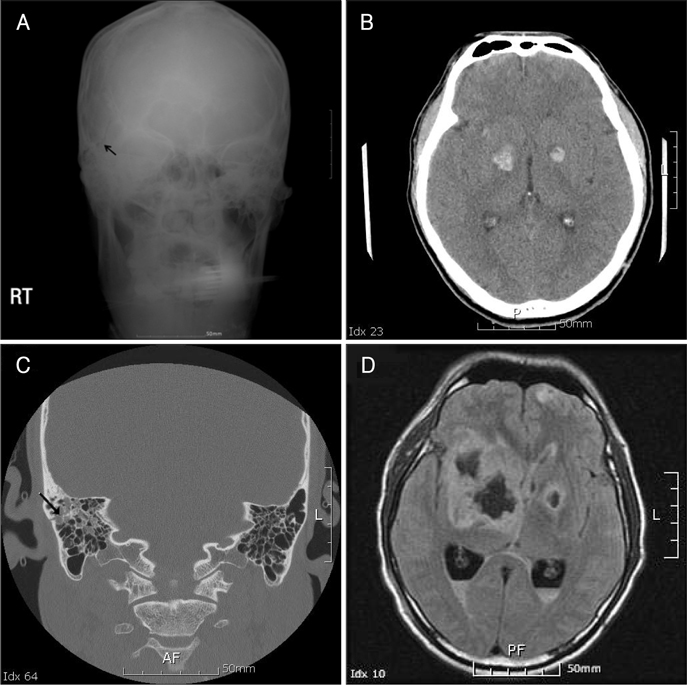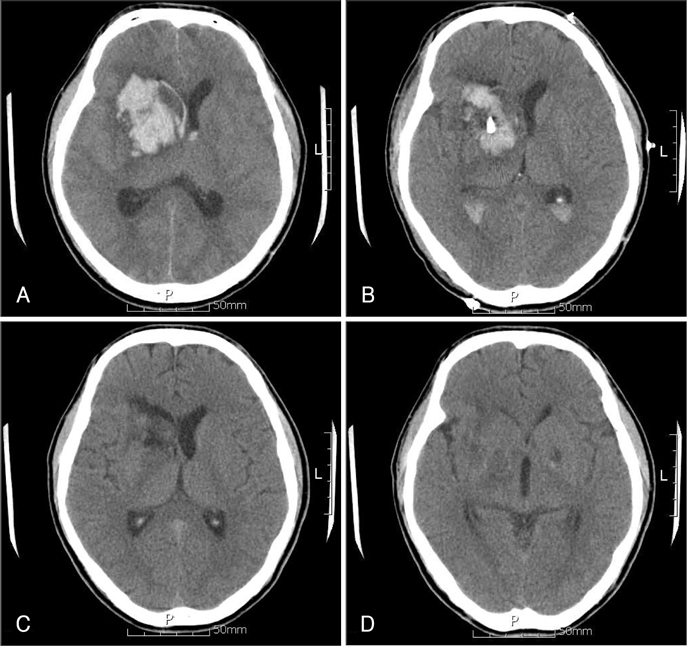J Korean Neurotraumatol Soc.
2008 Dec;4(2):89-92. 10.13004/jknts.2008.4.2.89.
Traumatic Intracerebral Hemorrhage in Bilateral Basal Ganglia
- Affiliations
-
- 1Department of Neurosurgery, College of Medicine, Inha University, Incheon, Korea. dkhyun@inha.ac.kr
- KMID: 2156156
- DOI: http://doi.org/10.13004/jknts.2008.4.2.89
Abstract
- Traumatic intracerebral hemorrhage in bilateral basal ganglia is a rare occurrence. A 43-year-old man was admitted after fight. Computerized tomography showed bilateral hemorrhage of basal ganglia. His medical history was not remarkable. He has no history of hypertension, diabetes mellitus and bleeding tendency. We concluded traumatic hemorrhage on bilateral basal ganglia with temporal fracture of the skull. The patient underwent external drainage of hematoma because the size of hematoma on right basal ganglia was increased at 3 days after admission. We shall report a rare case of bilateral traumatic hemorrhage on basal ganglia, and discuss the mechanism of development with literature review.
Keyword
MeSH Terms
Figure
Reference
-
1. Adams JH, Doyle D, Graham DI, Lawrence AE, McLellan DR. Deep intracerebral (basal ganglia) hematomas in fatal non-missile head injury in man. J Neurol Neurosurg Psychiatry. 1986; 49:1039–1043.2. Boto GR, Lobato RD, Rivas JJ, Gomez PA, de la Lama A, Lagares A. Basal ganglia hematomas in severely head injured patients: clinicoradiological analysis of 37 cases. J Neurosurg. 2001; 94:224–232.
Article3. Graham D. Neuropathology of head injury. In : Harayan PK, Wilberger JE, Povlishock JT, editors. Neurotrauma. New York: McGraw-Hill;1996. p. 43–59.4. Kang JK, Park CK, Kim MC, Kim DS, Song JU. Traumatic isolated intracerebral hemorrhage in children. Childs Nerv Syst. 1989; 5:303–306.
Article5. Katz DI, Alexander MP, Seliger GM, Bellas DN. Traumatic basal ganglia hemorrhage. clinicopathologic features and outcome. Neurology. 1989; 39:897–904.
Article6. Kim SH, Song SH, Youm JY, Kim Y. Clinical analysis of the traumatic basal ganglia hemorrhage. J Korean Neurosurg Soc. 1996; 25:1223–1229.7. Lee JP, Wang AD. Post-traumatic basal ganglia hemorrhage: analysis of 52 patients with emphasis on the final outcome. J Trauma. 1991; 31:376–380.8. Macpherson P, Teasdale E, Dhaker S, Allerdyce G, Galbraith S. The significance of traumatic hematoma in the region of the basal ganglia. J Neurol Neurosurg Psychiatry. 1986; 49:29–34.9. Mosberg WH, Lindenberg R. Traumatic hemorrhage from the anterior choroidal artery. J Neurosurg. 1959; 16:209–221.
Article10. Yanaka K, Egashira T, Maki Y, Takano S, Okazaki M, Matsumaru Y, et al. Bilateral traumatic hemorrhage in the basal ganglia: report of two cases. No Shinkei Geka. 1991; 19:369–373.11. Jang KJ, Jwa CS, Kim KH, Kang JK. Bilateral traumatic hemorrhage of the basal ganglia. J Korean Neurosurg Soc. 2007; 41:272–274.
Article
- Full Text Links
- Actions
-
Cited
- CITED
-
- Close
- Share
- Similar articles
-
- Bilateral Traumatic Hemorrhage of the Basal Ganglia
- Mirror-Image Intracerebral Hemorrhage in Basal Ganglia: Case Report
- A Case of Bilateral Simultaneous Hypertensive Intracerebral Hemorrhage in Basal Ganglia
- A Viewpoint on Treatment of Traumatic Bilateral Basal Ganglia Hemorrhage in a Child: Case Report
- Fahr's Disease With Intracerebral Hemorrhage at the Uncommon Location: A Case Report



